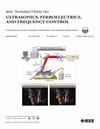基于非周期极化压电薄膜堆的谐振腔高阶模的产生。
IF 3.7
2区 工程技术
Q1 ACOUSTICS
IEEE transactions on ultrasonics, ferroelectrics, and frequency control
Pub Date : 2025-04-29
DOI:10.1109/TUFFC.2025.3565505
引用次数: 0
摘要
非周期性极化压电薄膜(APPF)堆叠最近被提出作为周期性极化压电薄膜(P3F)结构的延伸,P3F结构是将射频滤波器扩展到厘米和毫米波频段的一个有前途的平台。APPF堆叠层之间厚度的变化可以产生P3F结构中通常不存在的高阶模式,并为高频滤波器的设计提供了额外的选择。在本研究中,提出了一个简单的模型来优化三层结构中任意模态产生或抑制的厚度比。在优化结构的基础上,对谐振腔的导纳函数进行了严格模拟,并与实验数据进行了比较,验证了其有效性。128?中横向激发A1-A11模态的耦合系数基于YX - ln的三层堆叠作为连续变化厚度比的函数进行计算。这些依赖关系可用于选择APPF堆栈,同时增强主模式并抑制不需要的模式。在厚度为600 nm的LN板中,引入最优厚度的反转中间层后,在14.6 GHz和20.4 GHz频率上产生的A5和A7模式的机电耦合系数分别从2.4%提高到17%和1.2%提高到9.9%,而最接近的模式被抑制。解释了先前报道的实验P3F结构中虚假对称模式的出现,并描述了避免这些虚假模式所需的堆叠几何形状。本文章由计算机程序翻译,如有差异,请以英文原文为准。
Generation of High-Order Modes in Resonators Based on Aperiodically Poled Piezoelectric Film Stacks
Aperiodically poled piezoelectric film (APPF) stacks have recently been proposed as an extension of periodically poled piezoelectric film (P3F) structures, a promising platform for the expansion of radio frequency (RF) filters into centimeter- and millimeter-wave (mm-wave) frequency bands. Variations in the thicknesses between the layers of the APPF stacks enable the generation of higher order modes typically absent in P3F structures and provide additional options for the design of high-frequency filters. In this study, a simple model is proposed to optimize the thickness ratio in a three-layered structure for the generation or suppression of any mode. Its validity was confirmed by the rigorously simulated admittance functions of the resonators based on optimal structures and comparison with experimental data. The coupling coefficients of modes A1–A11 laterally excited in the 128°YX LN-based three-layered stacks were calculated as functions of the continuously varying thickness ratios. These dependencies can be used for the selection of APPF stacks with simultaneous enhancement of the primary mode and suppression of the undesired modes. In the analyzed lithium niobate (LiNbO3, LN) plates of thickness 600 nm, the electromechanical coupling coefficients of the modes A5 and A7 generated at the frequencies 14.6 and 20.4 GHz increased from 2.4% to 17% and from 1.2% to 9.9%, respectively, when the inverted middle layer of the optimal thickness was introduced, whereas the nearest modes were suppressed. The appearance of spurious symmetric modes in the previously reported experimental P3F structures was explained, and the geometry of the stacks required to avoid these spurious modes is described.
求助全文
通过发布文献求助,成功后即可免费获取论文全文。
去求助
来源期刊
CiteScore
7.70
自引率
16.70%
发文量
583
审稿时长
4.5 months
期刊介绍:
IEEE Transactions on Ultrasonics, Ferroelectrics and Frequency Control includes the theory, technology, materials, and applications relating to: (1) the generation, transmission, and detection of ultrasonic waves and related phenomena; (2) medical ultrasound, including hyperthermia, bioeffects, tissue characterization and imaging; (3) ferroelectric, piezoelectric, and piezomagnetic materials, including crystals, polycrystalline solids, films, polymers, and composites; (4) frequency control, timing and time distribution, including crystal oscillators and other means of classical frequency control, and atomic, molecular and laser frequency control standards. Areas of interest range from fundamental studies to the design and/or applications of devices and systems.

 求助内容:
求助内容: 应助结果提醒方式:
应助结果提醒方式:


